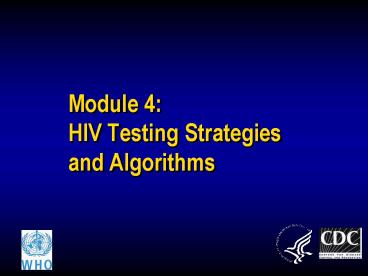Module 4: HIV Testing Strategies and Algorithms - PowerPoint PPT Presentation
1 / 22
Title:
Module 4: HIV Testing Strategies and Algorithms
Description:
Discuss the process for developing a national testing algorithm ... Explain the HIV rapid testing algorithm approved in your country ... – PowerPoint PPT presentation
Number of Views:128
Avg rating:3.0/5.0
Title: Module 4: HIV Testing Strategies and Algorithms
1
Module 4 HIV Testing Strategies and Algorithms
2
Learning Objectives
- At the end of this module, you will be able to
- Discuss the process for developing a national
testing algorithm - Explain how sensitivity, specificity,
positive/negative predictive value relate to
development of an HIV rapid testing algorithm - Explain the HIV rapid testing algorithm approved
in your country - Determine HIV status following a particular
algorithm
3
Content Overview
- Testing strategies and algorithms
- Developing national testing algorithm
- Measuring performance of HIV rapid tests
- Interpreting HIV status
4
Strategies and Algorithms
- Strategies Testing approach used to meet a
specific need, such as - Blood Safety
- Surveillance
- Diagnosis
- Algorithms The combination and sequence of
specific tests used in a given strategy
5
Strategies and Algorithms (Cont.)
- For a given strategy, multiple algorithms may be
used depending on the needs of testing settings - The number of algorithms should be limited
6
HIV Testing Strategies
- Parallel testing
- Samples are tested simultaneously by two
different tests - Serial testing
- Samples tested by a first test
- Result of first test determines whether
additional testing is required
7
Testing Algorithms Should be Developed at
National Level
- Key Steps
- Identify appropriate tests
- Develop algorithm
- Build consensus
- Develop policy
- Bring into national scale
- Review testing algorithms annually
8
Timeline for Developing National Testing Algorithm
9
Advantages of National Testing Strategies and
Algorithms
- Facilitates
- Country-level standardization
- Procurement and supply management
- Training
- Quality assurance
10
Key Factors in Determining a Countrys Algorithm
- Test performance in country
- Test availability in country
- Program needs
- Ease of use
- Type of specimen
- Cost
- Potential need to differentiate between HIV 1
HIV 2
11
Evaluating Test Performance Basic Terms
- Sensitivity (Se) of a test is its capacity to
correctly identify people that are infected with
HIV. - Specificity (Sp) of a test is its capacity to
correctly identify people that are not infected
with HIV. - Positive Predictive Value (PPV) is the
probability that a person who tests reactive is
indeed infected with HIV. - Negative Predictive Value (NPV) is the
probability that a person who tests negative is
not infected with HIV.
12
Calculating Sensitivity, Specificity, PPV, NPV
Actual HIV status (Gold Standard)
Test result
HIV infected
HIV -uninfected
Total
AB
Positive
B
A
CD
D
C
Negative
BD
AC
Total
Sensitivity A (AC) Specificity D
(BD) Positive Predictive Value A
(AB) Negative Predictive Value D (CD)
13
Calculating Sensitivity, Specificity, PPV, NPV
(Contd)
Actual HIV status (Gold Standard)
Test result
HIV infected
HIV -uninfected
Total
AB(372)
Positive
B (2)
A (370)
CD(628)
D (624)
C (4)
Negative
1000
BD (626)
AC (374)
Total
Sensitivity A (AC) 370 374
98.9 Specificity D (BD) 624 626
99.7 PPV A (AB) 370 372
99.5 NPV D (CD) 624 628
99.4
14
HIV Rapid Test Performance
- No test is 100 sensitive
- No test is 100 specific
- Note Performance of tests and subsequent
algorithm must be determined in context of
population
15
How Prevalence Affects PPV NPV
- (Prevalence) (Se)
- PPV
- (Prevalence) (Se) (1- Prevalence) (1- Sp)
- (1-Prevalence) (Sp)
- NPV
- (1-Prevalence) (Sp (Prevalence) (1- Se)
16
How Prevalence Affects PPV NPV (Contd)
PPV for 10 prevalence population (10/100)
(98.9/100) ---------------------------------
--------------------------------------
97.3 (10/100) (98.9/100) (1- 10/100) (1-
99.7/100)
PPV for 1 prevalence population (1/100)
(98.9/100) ------------------------------------
---------------------------------------
76.9 (1/100) (98.9/100) (1- 1/100) (1-
99.7/100)
17
Testing Algorithm Describes the Sequence of Tests
to be Performed
- An HIV Positive Status should be based upon the
outcome of 2 or more tests - When two test results disagree (one is reactive,
the other non-reactive), the finding is called
discordant. In this case, a third test must be
performed.
Always follow the sequence of the tests in the
algorithm
18
Ideal Algorithm
- Tests need to be
- Highly sensitive
- Highly specific
- Tests should not share the same false negatives
and false positives - 3rd test (if needed)
19
Testing Algorithm
Develop appropriate algorithm diagram (parallel
or serial) and insert names of HIV tests that
represent test 1, 2 or 3
20
Exercise Interpreting HIV Status Using Testing
Algorithm
- Refer to Participant Manual
- Work alone to determine HIV status
- 3 Minutes
21
Possible HIV Test Outcomes Parallel Algorithm
22
Summary
- Explain the importance of a tests Se, Sp, PPV,
NPV - Explain the testing algorithm adopted by MoH.
What rapid tests are used and in what order?































